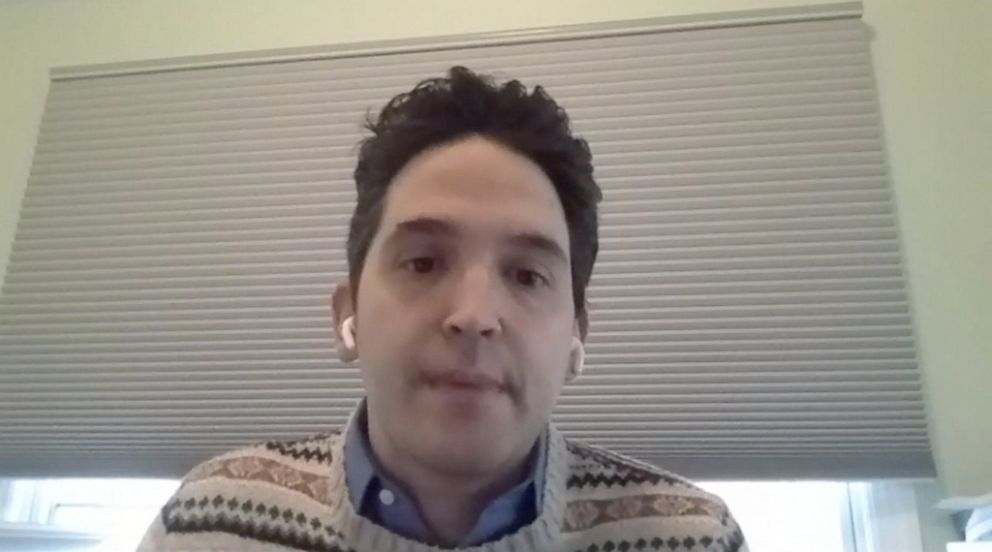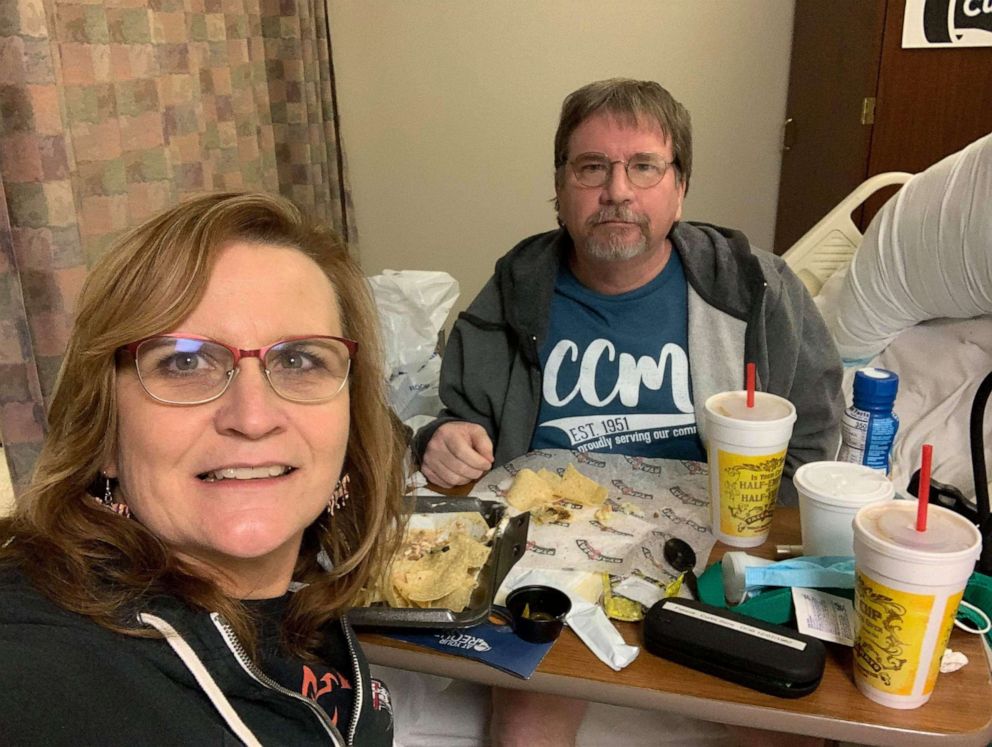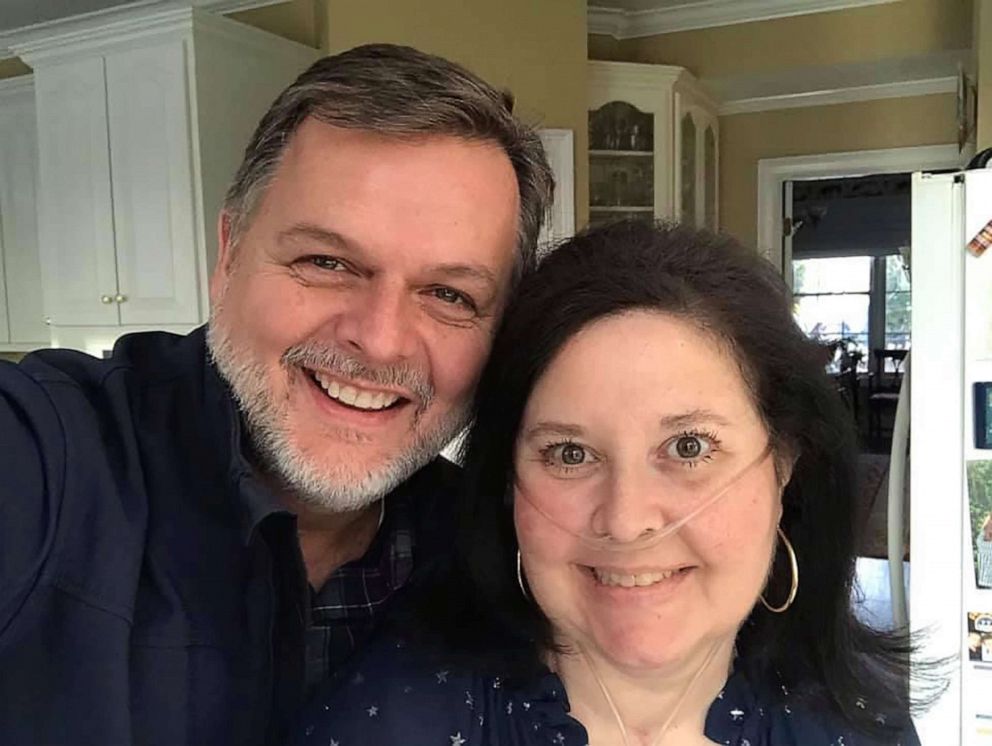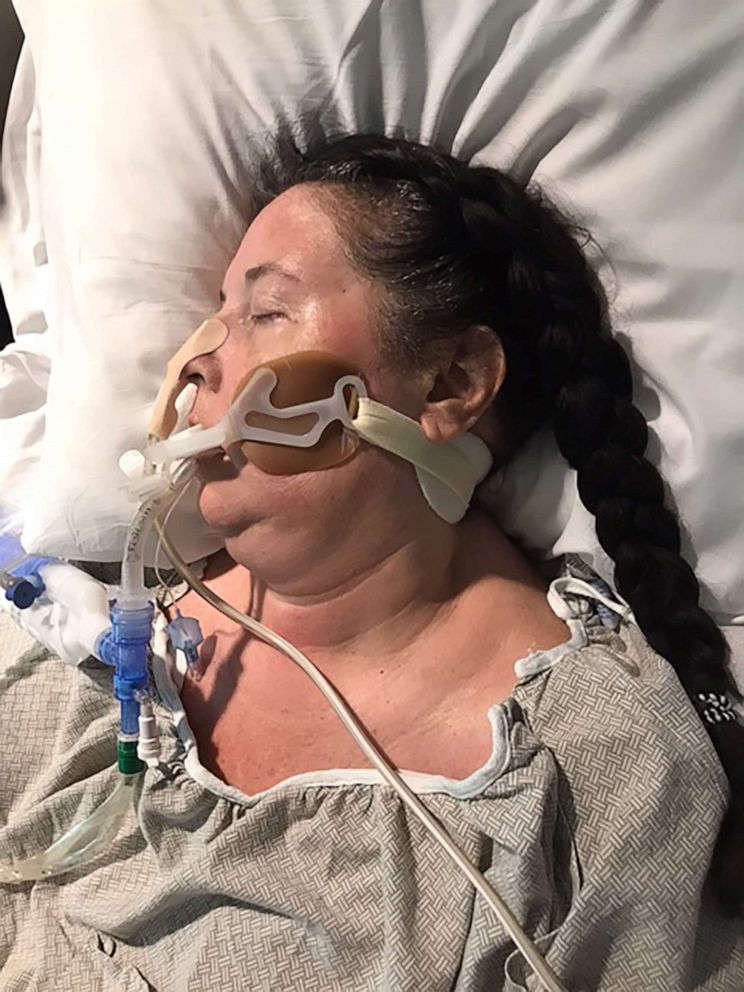COVID miracles: 3 healthy patients who nearly died from COVID-19 speak out
The health care workers who cared for them thought they may not make it.
The COVID-19 pandemic has been a story of profound tragedy -- for the families and loved ones of people who died and for the millions who wound up sick and hospitalized.
From Day One, the medical and scientific communities have been striving to understand the disease and combat and end the pandemic with therapeutics and ultimately vaccines.
What has been less visible in many cases is the lives doctors and other medical staff have saved -- sometimes in dramatic fashion and over the course of many months in some cases.
ABC News spoke to three COVID-19 patients who were on the brink of death and miraculously survived, despite all odds.
They walked us through what it was like to contract the virus and the difficulties they faced in their recovery.
Scott Krakower, 40, Long Island, New York

In April 2020, Krakower, the psychiatry unit chief at Zucker Hillside Hospital, in Glen Oaks, New York, had chills so intense that he had to jump into the shower to warm up. But at the time he didn't realize he was experiencing the onset of the deadly virus that was gripping the world.
Krakower first realized he might be experiencing symptoms of COVID-19 days later when he lost his sense of taste and smell.
"I kept eating and hoping and praying that that there would be like a taste of something," he told ABC News. "...And then, it just gradually went away completely."
Days after testing positive, Krakower's treatment began with antibiotics, preemptively in case he got a sinus infection. But, by the second week, his condition "dramatically progressed" and took a turn for the worse, he said.
Out of all of the treatments doctors tried, prednisone, vitamin C, and several others, "nothing was working," he said. Krakower lost his voice completely, had a chronic pain in his throat and developed a dry cough so severe he described it as a "loud, barking cough." His mucus turned bloody, and he knew he had developed inflammation in his throat.
At one point, Krakower said his throat was so swollen that he started choking on his food, including liquids, which prompted his loved ones to take him to the emergency room.
He was pale, emaciated and was experiencing labored breathing and was in and out of emergency rooms for weeks. He then traveled to Lenox Hill Hospital on the Upper East Side of Manhattan.
The emergency room was busy with several people coming in with critical cases when Lenox Hill emergency physician Dr. Robert Glatter first saw Krakower, Glatter told ABC News.
At the time, New York City had not yet hit its peak of COVID-19 patients as it became the epicenter for the spread of the virus in the U.S. Glatter recalled that Krakower's first concern was about patients who were sicker than he was, but Glatter had to remind him that, in his condition, he desperately needed treatment too.
"When I saw him, I knew he needed immediate treatment," he said, adding that he knew it was a possibility that he could require a ventilator down the road if he did not get the proper treatment.
At the time, there were no approved treatments for COVID-19, Glatter said, but he began administering the steroid dexamethasone through an IV, which acts as an anti-inflammatory and has the ability to regulate the effects of the immune system. Dexamethasone was found to reduce deaths among seriously ill patients in a UK study last year.
Within the first hour, Krakower's vital signs and oxygen levels improved and he regained some of his ability to speak. But his journey to recovery was far from over. Krakower was experiencing what Glatter described as the inflammatory effects of the virus.
He was discharged a few days later and able to go home, where he isolated in a room by himself, away from his wife and two children, who were 2 and 6 months at the time.
The rehabilitation was intense, he recalled. He was weak and had to practice walking again -- getting down the stairs without clutching onto the railing was difficult. He still could not speak and did not eat solid foods for about 2 1/2 months, as his throat remained swollen well into July. A home care nurse came twice a week to help him, and his meals and medications were brought to him by his wife. He Facetimed his children so they would still be able to see him.
Despite all that, Krakower kept thinking that he would get better, he said. Once he started eating solid foods -again -- with the first bite of pizza in August -- he felt like some semblance of himself again, he said.
Krakower said he feels "much better" now and blessed for all the help he received throughout his illness. He still coughs sometimes, but it's "nothing" compared to what it was like before. He is also thankful he never had to go on a ventilator.
"I think that if I didn't have such good people in my life, and my family...I would have been in a different shape than I am now," he said.
Curtis Sims, 58, Lawton, Oklahoma

Curtis Sims, a service manager at Great Plains Kubota, a tractor dealer in Duncan, Oklahoma, first tested positive on Oct. 19, but it wasn't until Halloween that he started to feel the effects of COVID-19, he told ABC News.
Sims initially thought he was dealing with a chest cold, telling his boss that he expected to be back to work in a couple of days after the quarantine period was through. But the symptoms worsened drastically and Sims said it was hard to breathe.
When Sims' wife, Suzanne Sims, dropped him off at Comanche County Memorial Hospital that day, he figured he would be going home later that day. But his condition continued to deteriorate. The last thing he remembered was a nurse who sat with him that night as he underwent sedation.
Sims remained under a medically-induced coma until late December. He was placed on a ventilator on Nov. 15.
Lacey Anderson, an ICU nurse at Comanche County Memorial Hospital, told ABC News that when she first saw Sims his entire body was swollen -- likely due to his kidney or other organs not functioning properly and therefore not able to flush out the fluids and other medications being administered to them, she said.
Anderson, who cared for Sims for three days, was not sure he would make it through his treatment. On the fourth day, he was airlifted from the small hospital to the University of Oklahoma Medical Center in Oklahoma City.
Anderson was distressed that she could not offer Sims' wife any good news when she came to see him that day.
"I just kept thinking...'Please, God, let him make it through this. Let him be able to get on that flight to get to OU today," she said.
While at OU, Sims' family was called into the hospital to potentially say goodbye. Sims had specified on his "Do Not Resuscitate" order to only revive him twice, and he had already coded as many times, he said.
When Sims woke up, "everything was foggy," he said. It was difficult to remain calm and to push enough air out to talk. He did not have his phone or his glasses. When the medical staff asked him questions, he answered as best he could.
"I was basically just guessing and hoping that I would get better," he said.
It was not until several days later, as he came to, that he started to ask questions. He did not realize how much time had gone by -- that he missed his birthday, Thanksgiving, Christmas and his father's funeral. He did not know he was in Oklahoma City.
"When you wake up and you've missed that much time, it's hard to go back," he said. "I mean, you just can't. You don't know how to fill in those pieces in your day...in your mind. It's just all blank."
Sims started feeling better around mid-January and was discharged on Jan. 28 to a rehabilitation center. He required therapy, to learn how to swallow again. The first solid food he ate was lasagna, and the first thing he set his sights on when he was able to go home on Feb. 12 was his recliner chair.
When Sims first visited Anderson at the Comanche County Memorial Hospital, he was unrecognizable, she said. Sims' case was a breath of fresh air among all the devastation the medical staff has faced in the past year.
"It brought tears to my eyes," she said. "I was just so excited because...we don't see that very often at all. And it was just so motivating for me."
If Sims could go back, he would change his stance on wearing a mask. He believes he contracted the virus at work, where he felt it may make customers uneasy if he were wearing one and they were not, he said. At the time, Oklahoma did not have a mask mandate in place.
"Just wear a mask," he said. "It's so simple."
He is now feeling "a whole lot better," he said. "It was some pretty dark days there for a while."
Lisa Martin, 50, Blackshear, Georgia

Lisa Martin at first tested negative for COVID-19 in September, but she felt the result could not be right, she told ABC News. Her husband, Jeff Martin, a small business owner in southern Georgia, had contracted the virus, and she did not believe that she could have escaped it.
"My husband and I sleep in the same bed, share the same bathroom," Martin said. "Every so often, I might pick up his toothbrush, and we're just together all the time."
Martin's inclination turned out to be true when on Sept. 27 because began exhibiting severe symptoms of the virus. Breathing and coughing was painful, and she had a "raging" fever and chills. The only time she felt any sort of relief is when she was getting in and out of the shower, and in an attempt to break her fever she took a dip in her backyard pool -- but it did not work.
"I said to my husband, you've got to take me to the doctor, or I'm going to die," Martin said.
When Martin got to Memorial Satilla Health in Waycross, Georgia, she did not know it would be more than three months before she would go home again.
She was so ill that within 20 minutes she was getting fluids through an IV. After that, she "completely zoned out" for the next 90 days, she said. She was placed on a ventilator and later moved to Memorial Health in Savannah.
Martin had already been intubated for about a week when Dr. Roberto Lopez Vega, an internist at Memorial Satilla Health, first began to care for her. At the time, she was in need of a lot of oxygen -- the highest the machine would go.
Lopez was worried about Martin's prognosis. The longer someone is on a ventilator, the higher the chances something else could happen, such has kidney or liver failure, he said. When it was time to transfer Martin, she was so unstable that disconnecting her from one ventilator and hooking her up to another became too risky. They had to wait until she was stable and then eventually transferred her.

And then, despite the high oxygen settings on the machine, her oxygen levels began to plummet -- consistently and for several hours.
"That day was the day that I thought she was going to leave us," Lopez said.
But in the next few days, her numbers started improving. She did not need as much oxygen, and each day she got better, Lopez said. Despite that, medical staff knew Martin had a long road ahead. She was very sick, especially her lungs, Lopez said.
After Martin woke up, she remembers being "amazed" at how much she missed during three months of being unconscious. She was also relieved, because she had several terrifying hallucinations while sedated, including one where her son died in a bus accident.
"I was so relieved to have woken up from the hallucinations that I was happy to be alive," she said.
The doctors and nurses who cared for her feel the same, several of whom have told Martin how it is a miracle that she is alive today.
Martin missed Thanksgiving, Christmas and many birthdays, but the mother of four was discharged on New Year's Eve and spent the holiday with her family.
She is still in rehab, where the first thing they worked on was speaking again before moving on to eating and occupational therapy, including basic tasks such as dressing herself. She can not wait for the day she can drive again and regain her independence.
Martin's sense of taste and smell is still affected -- everything tastes bad, she said. She lost all of her hair, her bottom lip and pinky finger are paralyzed and her hands numb. The tops of her feet have no feeling, and she has little endurance. Walking to and from the bathroom is taxing, she said.
Martin admitted that she experiences guilt for surviving. She still feels surreal and shocked when she thinks about what she went through, she said.
"Still to this day, my children are filling in details that I just have no clue that occurred, and I just get so sad and teary for what all they had to go through," Martin said.
Healthcare workers are exhausted
The men and women caring for the patients who become infected with COVID-19 have now been on the front lines of the pandemic for more than a year.
But it is cases like these that they say keep them going.
Comanche County Memorial Hospital, where Anderson works, is small and very few nurses work per shift, she said. A week before she treated Sims, five patients crashed at the same time.
"And so to have that many people going down all at once was just overwhelming," Anderson said. "...I think we all went home in tears."
Anderson described the difficulties and exhaustion she and her colleagues go through on a daily basis. She recalls doing everything she could for Sims, including playing some of Adele's music after his wife mentioned he liked it.
"It's such a blessing to get to see Curtis and talk to him about what was going on, because the motivation for us nurses is really diminishing," Anderson said.
Martin said several of the healthcare workers who cared for her get emotional when they see how well she is doing, emphasizing that it is not the case for most patients in similar conditions.
"They would talk about how they put so much time and energy and effort into their patients and their pain. Their patients pass," she said. "and so it is refreshing to actually see someone who survived."
The past year has been "tiring" and "devastating" for everyone in the medical field, from physicians to those in patient services, Lopez said.
The more common outcome is the opposite of Martin's, where the patient is unable to pull through, Lopez said.
"We all want cases like this to multiply and have many, many more," he said. "But, unfortunately, they're very scarce."




